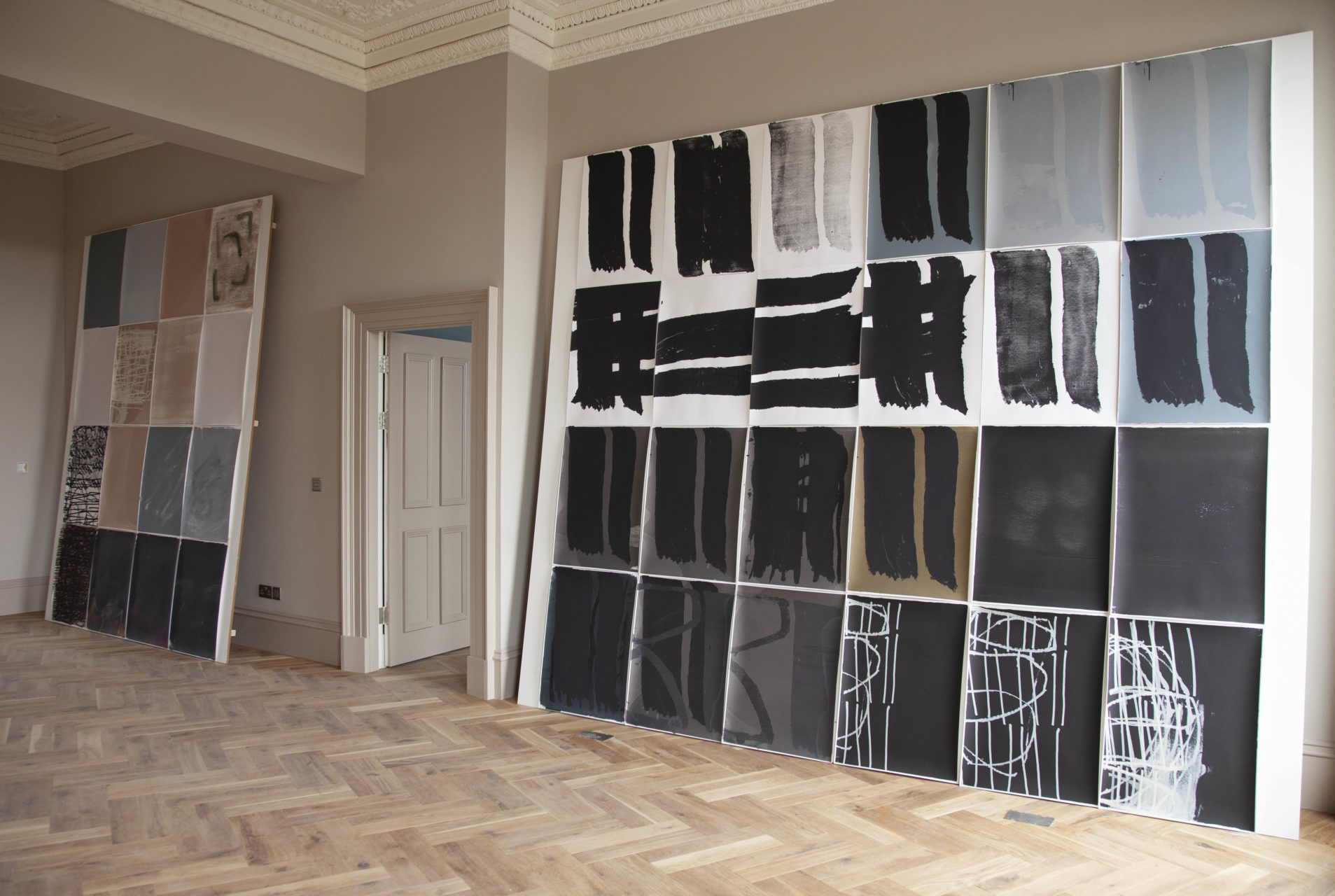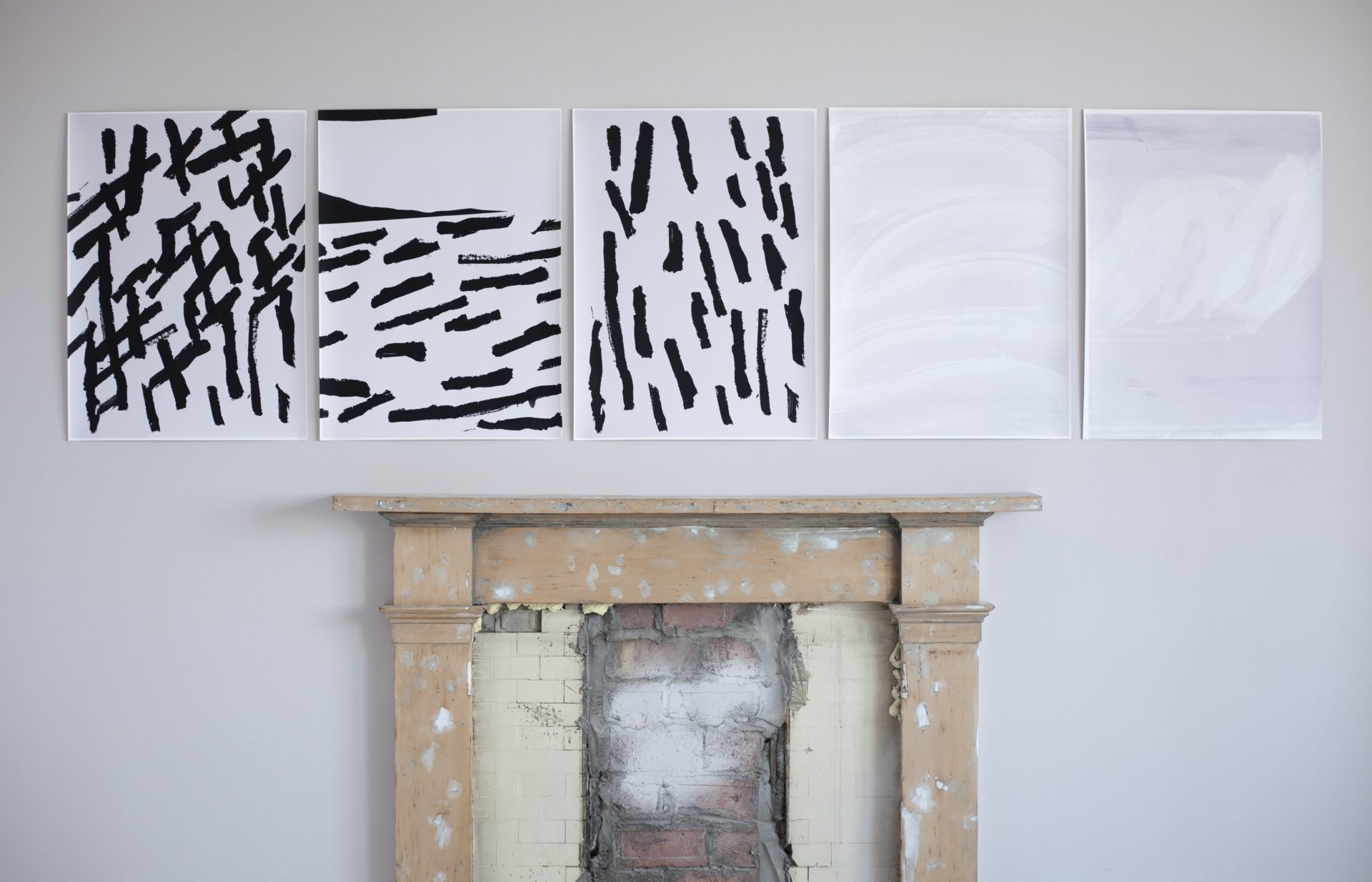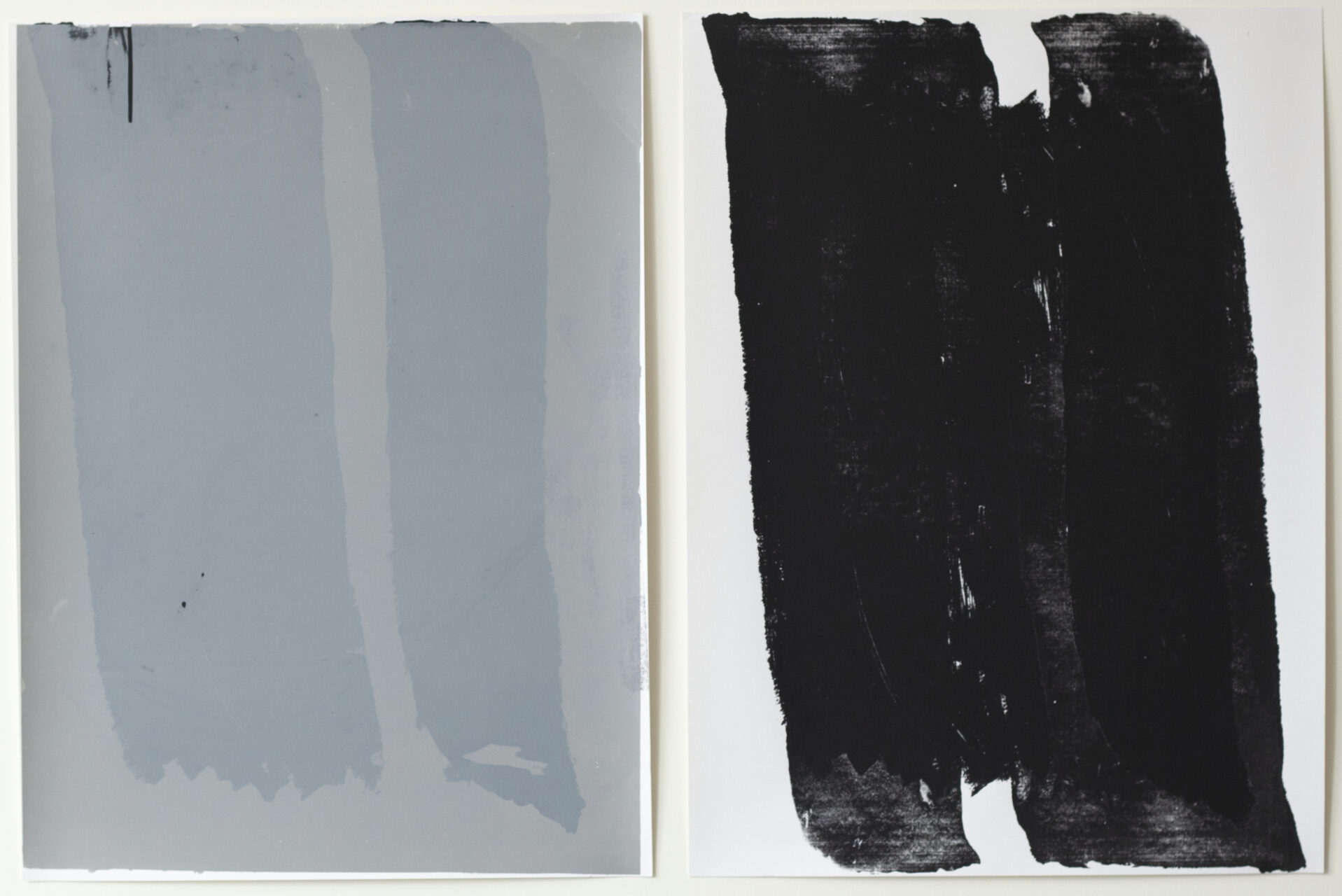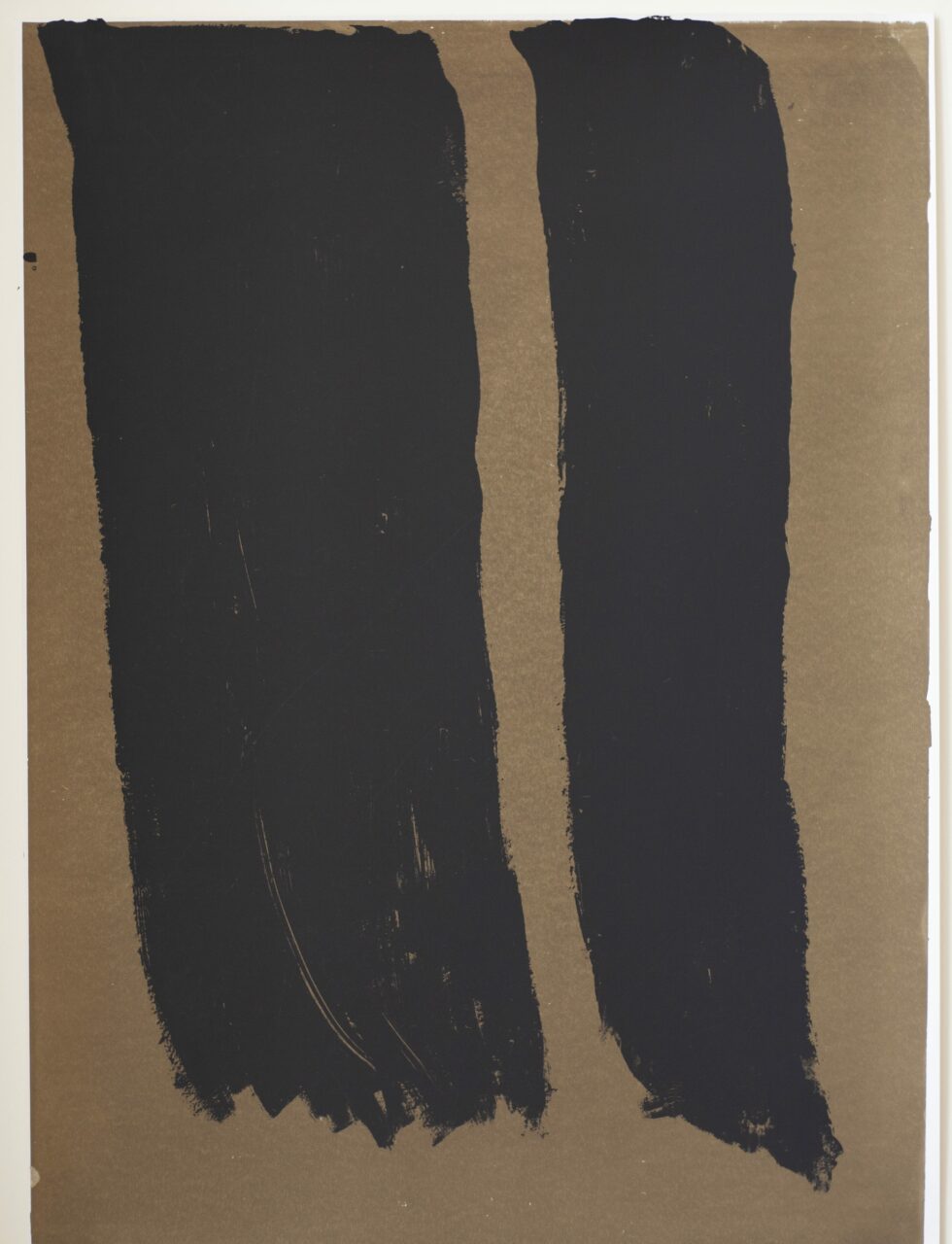Two-Step at The Hidden Door Festival
by Beth Shapeero and Fraser Taylor
Six hanging textile works combining screen print and painting commissioned for The Hidden Door Festival in Edinburgh
September 2021


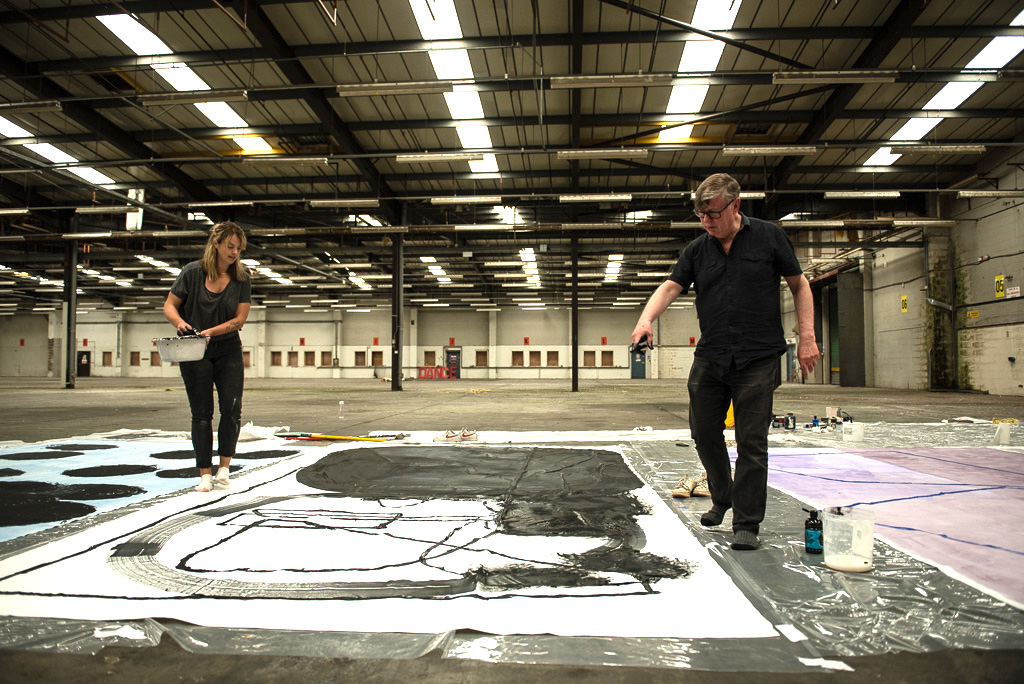
Two-Step at The Hidden Door Festival
by Beth Shapeero and Fraser Taylor
Six hanging textile works combining screen print and painting commissioned for The Hidden Door Festival in Edinburgh
September 2021



Selvedge to Selvedge
An installation of screen-printed fabric at The Briggait, Glasgow.
Displayed in the window spaces of the gallery, the work could be viewed from the street even during Covid closures.
April 2021, in collaboration with Fraser Taylor



Birds, Rats and The Dark
by Simon Buckley
“What happens to the hole when the cheese is gone?”
― Bertolt Brecht
For Govan Project Space (GPS) Beth Shapeero and Fraser Taylor will exhibit collaborative works together for the first time. The exhibition will comprise of one large site-responsive installation. The back wall of the gallery, which ascends to approximately forty feet, will be clad in a grid of a 120 (A2) screen prints. Presiding over an otherwise empty gallery space, the installation will appear as a vast ensemble of colour, shape, line and form; a jostling composition pushing and pulling the visitor around the space (by their eyes and their feet!). It will operate as a loquacious babble of visual chatter in which every component and moment will play a vital compositional role, yet shall serve no (sensible) informational function. Already, there’s a hint of the absurd (and we’ve only just begun!)
As the viewer approaches the vertical mass, the details will begin to emerge. Colour avenues, lines and paths, weighted corners, sinking lumps, protruding bumps, syncopated crashes and plateaued quiet spots will all start to be exposed in the vertical landscape. After exploring the grid for a little while, it will become clear that there’s both a great diversity and remarkable continuity apparent in the aesthetic language. The individual prints could be described as non-representational insofar as they’re not clearly depicting or representing anything that I obviously recognise form the real world. The temptation will therefore be to describe them as ‘abstract’. But I’m not sure about this however. There’s more to them than this. It seems a bit like a trap they’re laying out for us. There’s something in the way these lines are weighted, the urgency with which these and forms move in, around and over each other that harbours something of the blueprint – a plan of some sort? I don’t know. I can’t work it out yet. Give me a minute. I’ll get back to you.
Sometimes the shapes will allude to the third dimension, sometimes they’re completely flat. Sometimes the trace of the artists hand is the dominant visual feature and sometimes a malfunction from the printing process seems to be the first thing I’m drawn to. I could carry on like this. In fact, I think I could find any number of influences, stories, directions and ideas to follow within the rich density of the installation (as I am sure many a viewer will be quite happy doing). And that would be fine. However the installation’s almost Brechtian disinterest in any linear notion of temporal or automated narrative encourages me not to pursue these (undeniably enjoyable) methods of engagement for too long. Instead I find myself starting to consider questions of process and authorship. These works seem to be about themselves more than anything that they point towards through their ‘content’. They seem to be about how they’ve come to exist. And that’s fine. That’s more than enough.
The result is work(s) whose final condition is somewhat accidental, yet is also precisely determined by the velocity of the artist’s relationships with both each other and the printing press. And here we see the collaboration harnessing a tension between limitation and liberation. Once freed from any apparent notions of planning, formal representation, content or theme, the works are able to truly investigate (themselves), experiment, play and even fail. This freedom is primarily born in their interest in producing technically ‘bad’ prints, in embracing chance, spontaneity, failure as creative devices.
But I think we can go a step further. I think in virtue of working with each other, further elements of uncertainty are allowed to enter into the(ir) production process (Ah ha! Maybe this is where I was getting my blueprint sensation from! This is a blueprint of itself!) It is clear that there is a profound sense of understanding and shared aesthetic sensibility between them, but what’s much more exciting (and much less common!) is to see the development of works where understanding and sensitivity results in challenges, pushes, intensity and a resounding embrace of the unknown.
In conversation they explain how they often pass a print back and forth during the various stages of the printing process, executing the different stages separately, setting up an almost like a conveyor belt like system. The result then is product of which neither of them has fully determined, or can be totally sure of. It is a process that allows them to enjoy their materials and lets the exploration of the (intrinsic and extrinsic/relational) limits determine their trajectory. It seems to operate almost as a process of purposeful play.
And then there is ‘the excitement’ (again their words) of lifting up the press to see what they’ve created… to see if they’ve got a good one. Or ever better, a bad one! Or EVEN better, one which doesn’t seem to permit such dogmatic ascriptions. Indeed, the second stage of their production seems to be necessarily severe – a complex editorial process of post-rationalisation and formal categorisation. How they select which pieces are to be shown is (I assume) once again a process led by the works themselves, except this time through a reflective and calculated assessment of the semantic and syntactic properties of the pieces. The rhythm between the individual units sets up an evasive set of relationships, simultaneously alluding directly to the presence of a value system of some sort informing the editorial process, yet never allowing this system -whatever it may be- to be fully exposed.
Beth Shapeero & Fraser Taylor
By Lauren Printy-Currie
I see a dance performed on paper. A meandering line of charcoal that could have been attached to a limb. Marks creating by moving around, as we do, to the beat of the day. From each picture to the next, there is an abrupt scene change. I see an interplay between two people that lasts and lasts until it has established a level of its own, becoming its own. I see two people surrendering to the process, trying to leave themselves behind. This is a true constant across the variation of lost bodies on the pages, claiming their space, improvising and rising in inimitable movements. There is a fabric of interconnectedness, acts with consequences, bodies that shiver, pull faces, tick, get in a twirl, become caught up, entangled or remain still and solid. They have claimed this blank space, rising. I see a directness ‘dance’ across every surface. I do not only see the drawings, I experience them bodily too, at times fluid and running in a kind of loop, where the first and last actions feed one another in spatially fragmented choreographies. Touched by something unexpected, colour becomes an arena. These circles, lines, blocks, grids, swathes, strips, stripes, folds, positions, impressions, groups, paths, are going somewhere, getting everywhere. The shape each one finds itself in isn’t the only possible shape it could ever be, I think. I am spending a period of summer away from home, in a place by the sea that is arid, hot, dry, dusty, and salty. But beautiful. As I write this, I see
the calm slick of the ocean blue__
the twinkling of the sun on its surface, stubborn and red behind my eyeballs,
its faint glow at some points gentle, but otherwise ablaze in an aimless white light.
a green beach towel on sand, my impression on it, soft as one another
the blank face of someone who’s had bad news
dirt under my fingernails
red wine in a glass
the pearlescent sheen of the inside of a shell
the pink to white shift of my nail bed as I press my finger onto a hard surface
a woman’s outfit and the optical play where blue meets red
All of these things, not so much to be mixed on a palette but seen. I feel if I were to take their temperature, they would be warm. I see colour as a place or a sound or a feeling or a flag waving, the wind forcing it taut for a moment before releasing. I ponder these drawings together while staring, mesmerised, at the sky, the blue sky, the most accessible place in the world for reverie. I plunge myself inside and warm up.
The Singular En Masse: Meditations on the Collaborative Practice of Beth Shapeero and Fraser Taylor
by Simon Buckley
SLIDE 1:
‘If you wish to make an apple pie from scratch, you must first invent the universe’
Carl Sagan (2011)
BANG. Pure energy. A few seconds of unimaginable blistering intensity. Matter forms. Years, centuries, millennia, millions, billions of years pass. Atoms firing through space. For three hundred million years the ever-persevering force of gravity brings the atoms closer to each other. Soon they will be baked into galaxies.
There are heavier elements starting to form. Planetary systems are beginning to emerge. Defined galaxies, evolving out of thin air then exploding away. Several billion years pass. The milky way is forming. Our sun. The planets. Earth! Soon the dense atmosphere of oxygen and hydrogen will start to form water. And with this, it will begin to rain, for millions and millions of years.
The oceans have formed: a rich soup of minerals, being pushed and pulled into countless molecular shapes and patterns through an array of processes and actions. But one of these patterns is ‘smart’ – a coordination with something different, something of a memory, something that adapts to what has come before. It repeats. It fails. It repeats. It fails better. Millions of years pass. It is now the first identifiable living cell. Crude, basic but transferable.
The cell’s primitive state encourages a wide variety of testing and application to occur, relentless variations, reptations, overlays, inversions, insertions and removals occur. Fail. Fail Again. Fail Better. Molecular exploration. But it’s working. The cellular life-form is starting to proliferate, its components evolving, shifting, regressing and mutating with the passing of time. Millions of years pass. Multi-cellular beings. Millions of years. Complex multi-cellular beings.
The oceanic kingdom is now alive. Some species will soon turn amphibious, then terrestrial. Complexity built out of simplicity (and then vice versa). There are now some iterations that are starting to grow a measurable sense of intelligence. The sharpened tip of this swollen and fragile dance pushes on with ever more success. The terrestrial kingdom proliferates. Forests, animals, dinosaurs, insects, apes, primates and in time hominids.
BANG (PART 2). Earth is struck by a meteorite. All life larger than rabbit is wiped out. Everything that has come before is nearly thrust back into an indifferent silence. But not quite. Millions of years pass. The rout of everything that could have been has left a space, a space free from predators which has allowed the gentle dance to regain its momentum, to re-learn everything it had nearly forgotten. But this time there are no further interruptions. This time the hominid species will become bipedal. They are learning to use tools, to build fires, to cook, dance, love, sing and paint. They are growing wheat and farming fruit. They have automated their cooking processes. They call it an oven. And sitting inside of it is a hot apple pie. Bing! And it is done.
Part 1
It started with a back and forth of text messages. After agreeing to write about Beth and Fraser’s work, I immediately started thinking about the vast array of routes to approaching their collaborative screen-printing practice, a project that had been titled ‘Two-Step’. Given that they’d offered me an unusually open mandate about how to engage with the task of writing something, I felt that the best way to start would be to view some of their recent prints up close. I messaged them to see if I could have some of their works dropped off to my flat, so I could live with them for a week or so. I suggested around six prints for the period of a week (one a day if you will). Kindly, they agreed.
The plan was (at least I thought) to have the first six prints dropped off at 15:00. It was 10:00 now, so I had plenty of time before they’d arrive. As such, I decided to make the most of a break in the weather and go for a run. I’d use the time to think about what I already knew of their work, namely, that they were prolific in quantity and diverse in presentation. In the last year alone, I’d seen hundreds of their prints presented en masse, alone, in pairs, in rows, in grids, unframed, framed, on big custom-made walls, in small little stair wells, in commercial galleries, project spaces, studios, domestic spaces, on Instagram, in piles, on websites, on tables, on Facebook and in coordination with their respective solo prints and paintings (both old and new). Anyway, a gentle run to ruminate and I’d be back in plenty of time, refreshed and energized from the exercise, ready to discuss my ideas and start this process in earnest.
Now, I don’t know about you, but running can go two ways for me – good or shit. I don’t know how I always seem to forget this, but predictably enough, my morning run prior to the prints arriving took the latter route. I had felt heavy legged and tired from the first corner – hot, slow and pissed off. I had persevered and dragged myself to the hour mark, but at some cost. So, far from dancing with endorphins on my return to the flat, I felt wrecked. A wheezing shell of a human. At least I could have a shower and re-group.
Keys turned. Door opened. Beth is kneeling on the living room floor spreading prints around like she is setting up a vast abstract boardgame. Play it cool. I could already see there was more than six. I could also see that the box that she was taking them out of was swollen with more waiting to emerge. Had I got the times wrong? What was the time? So thirsty. Aware of the smell drifting up from my stinking running shoes, and starting to feel the cool trickle of sweat on my bright red forehead, I was the picture of unprepared, trapped in the discomfort of a failure utterly of my own design. Gulp.
SLIDE 2:
“We are not interested in the fact that the brain has the consistency of cold porridge.”
Alan Turing (1959)
Part 2
“A heap of broken images, where the sun beats, And the dead tree gives no shelter, the cricket no relief,
and the dry stone no sound of water.”
T.S Elliot. The Waste Land (1922)
After a glass of water and Beth’s departure, I began to regain my composure. On starting to look properly at the prints that had arrived, I was once again immediately struck by the scale of the Two-Step operation. I also knew that the eighty or so prints that were spread across my living room floor, hallway and studio were just the peaking tip. Gulp indeed.
As for the appearance of this particular group, they seemed a little bleaker than I had perhaps seen from them before, both in tone and semantic allusion. The warm off-whites and cool pale tones that I’d seen most recently had given way to staccato greys, pallid browns and jarring schisms of black and white, both rhythmically mesmerizing and syntactically unsettling. Erasure, layering and overload seemed to now be being tested as forces for progression. There was an almost geological brutality to their movement, a heaving indifference and weight. They seemed more uncompromising than before, yet equally seductive.
A reoccurring formal strength of everything that Shapeero and Taylor produce is their ability to present shapes, colours and lines that just about allude to the idea of something familiar (something from our world), whilst simultaneously remaining within the realm of abstraction. Tilt your head. Now that collection of lines almost makes its way into the shape of a falling figure, but by the time you’ve seen it, it’s floated back into being a group of lines blowing across the page. Oscillating between polarities with such ease is both beguiling and disconcerting. Perhaps then I shouldn’t have been totally surprised that as I went through this particular set of prints, their stark image planes began to flicker between telescopic scans of the night sky, to microscopic close ups of molecular cultures; from dead lunar wastelands of beige, to ultrasound scans of fetal life; from frenetic white noise to deafening mechanical silences (and of course, simultaneously none of the above!)
There were notable visual progressions and adaptations too (perhaps just from the way they had been stored and delivered to me), discernable aesthetic steps being repeated and refined, only to then to be cut off in mid-flow – severed brutally back into an uninterested silence. Around some of the images edges there were thin flashes of primary colours. They appeared as dying embers of what they had once been, evidence that development can be brutal; that death is itself a species of progress.
In the face of this particular group, and indeed such a vast and multi-directional practice, I realised my request for six prints had perhaps been an attempt to impart some constraint onto how I might begin to approach this task. For better or worse, this request had gone unheeded. But thank goodness it had, as it was through this miscommunication that I was –in time– able to identify what I now realise had always captivated me about the collaborative practice of Shapeero and Taylor: the relationship/tension between the singular and the crowd.
SLIDE 3:
For analytic philosophers of consciousness, there is no greater challenge than what is known as ‘the hard problem of consciousness’. Unlike the so-called easy problems, such as explaining how the brain integrates information, categorizes and discriminates environmental stimuli or focuses attention, the hard problem of consciousness is concerned with how the inordinate complexity of the brain’s physical processes result in how (and why) it feels like ‘something’ to be here now. How do millions of tiny electrical charges firing around the hundreds of billions of neurons, interneurons, motor-neurons, Betz cells, glial cells, neural-stem cells, blood vessels and cerebellar Purkinje cells result in ‘the taste of apple pie’? How and when does a system become complex and ornate enough to produce/be accompanied by ‘experience’? There’s also a couple of extra hurdles that make the hard problem so, well, hard. First of all, the human brain is –by a distance– in the single most complex entity in the known university. As such, it’s pretty hard to understand. Second, we’re all stuck inside of one, and as such, are left trying to unpack the car from the inside out. So where does this leave us with answering the hard problem of consciousness? We basically don’t have a Scoobies.
Part 4
Over the next few weeks, I diligently rotated the seventy-seven prints around several designated spots in my living space. And I slowly but surely started to unpick a complexity belied by their unassuming compositional lucidity: how they existed both as individual works and as components within an ever-expanding body of work. And here we have it: a collaborative practice that is simultaneously completely confident in its operational scale, strategies of process and methods of presentation, yet remains completely vulnerable, delicate and generous in its present moment – in my experience of being here now with it. You see a lone print. You move closer. You start to realise that this individual work is another whole multimodal universe in its own right, replete with its own patterns and processes of repetition, variation, replication, reflection, impression, allusion, regression, misdirection, layers, colours, shards, fractures, familiarities and oddities. Each work is its own distinct moment, and yet through each individual print we can feel the weight and knowledge of all that has formed it, everything that it has been and is no longer.
The End of it All
But let’s get back to the apple pie for a moment shall we. The point Segan was moving towards with his remark is the vast and unavoidable interconnectedness of all things; to the holistic and brain frazzling reality of all humanity, nature, biology and chemistry being a part of the same whirling system of interacting forces. So, although an apple pie may feel like a completely distinct (and hopefully delicious) entity you just made this afternoon, it is nonetheless intrinsically woven into the fabric of the universe, as are you and I. The point I am moving towards is that the same is true of any individual print of Shapeero and Taylor’s (both within their own universe, and of course ours too). This is, to an extent, true of any artist’s practice insofar as one thing will always lead to the next – formal and conceptual traces, elements and fragments will consciously and subconsciously be carried forward, whilst other aspects will be dismissed, mutated or reformulated into something else. With Shapeero and Taylor however, this process of evolution is so explicit and powerful, it warrants specific remark.
My citation of The Turing test and reductionist and materialist theories of consciousness is of course not an attempt to suggest that their practice could in any way be considered sentient. Rather my intention is to draw attention to the insatiable human impulse to understand, to contain and to control – an appetite Two-Step very much speaks to. Natural and with valuable evolutionary function though they may be, human endeavor for apprehension and categorisation (and the closure they bring) can devalue/distract from the importance of being faced with realities we do not, and will never ‘understand’. Two-step serves to remind us of the tension of being alone in the crowd, and that remembering this side of ourselves is to reconnect (however momentarily) with the inherent beauty of an existence built upon uncertainty, indifference and contradiction.
At the start of this text, I expressed an apparent concern at my own ability to tackle the scale of their operation, wondering where it might be best to begin. I now see that my fear was not about where to begin, but rather once in motion, when and how to stop (perhaps something they too feel?) To closely study their practice is to feel its gravity pulling you in. My cowardice however, can be used a barometer to reflect the raw power and delicate nuance implicit to both the macro and micro aspects of Two-Step. It’s massive. It’s getting bigger. Yet every corner of every print is brimming an unimaginable blistering intensity of detail, hope, history and most importantly, a hunger for whatever is coming next. Try again. Fail again. Fail Better.
“All I know is that to me, you look like you’re havin’ fun, open up your lovin’ arms, watch out, here I come”
Dead or Alive (1984)
Beth Shapeero & Fraser Taylor
by Lauren Printy-Currie 2018
by Simon Buckley 2018
by Gwenan Davies 2020
by Jan Patience 2020
Beth Shapeero: The Shape of Things
by Alice Bradshaw 2022
Tiny Paintings
by Beth Shapeero
The Tiny Paintings occupied a top floor bedroom of a 5 story Glasgow townhouse development. Shown alongside Two-Step in August 2020. Works measure approx. 5 x 4.5cm.



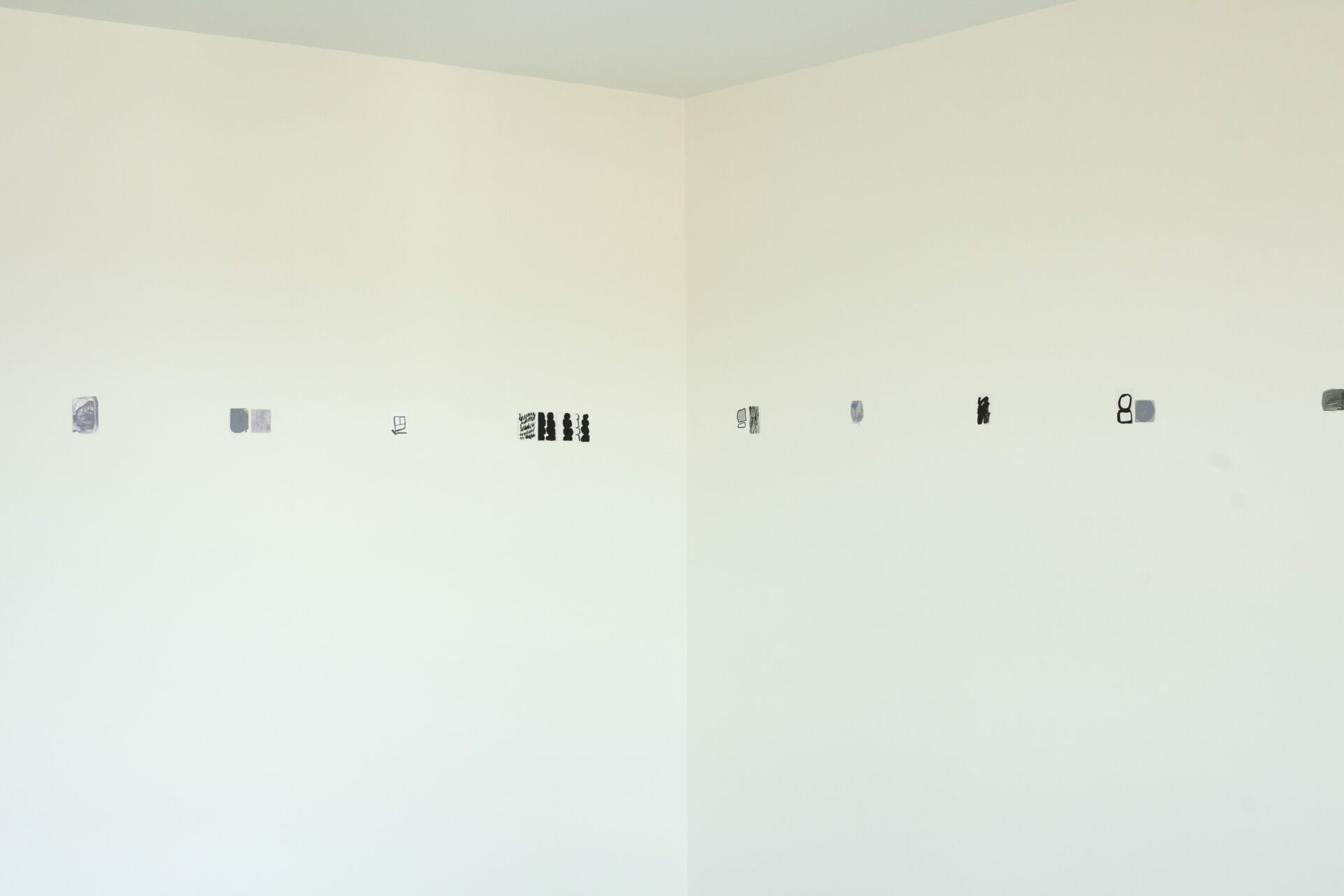



Two-Step at The Loading Bay
Two-Step installation in The Loading Bay skatepark in Glasgow.
The works were installed during the closure of the skatepark due to Covid restrictions in December 2020.




A4 drawings posted back and forth between collaborating duo Beth Shapeero and Fraser Taylor during the first major lockdown period; March – May 2020.
111 collaborative drawings were created during this period.
Two-Step is an ongoing collaboration which began in 2017.




























Two-Step 8 Woodside Terrace
An exhibition in Glasgow townhouse development featuring Two-Step works by Beth Shapeero and Fraser Taylor. The show took place in August 2020 in the midst of Covid restrictions, viewings were possible via scheduled appointment slots in groups of 20. It was the first event/real life art experience any of us had taken part in in some time.
Produced in collaboration with From The Studio, www.fromthestudio.art, and featuring work by Ruby Flowers, www.rubyflowers.co.uk.
